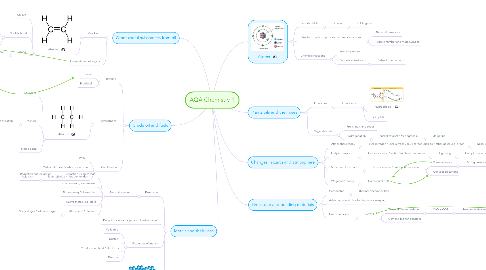
1. Metals and their uses
1.1. Extraction
1.1.1. Reactivity series
1.1.1.1. Extraction using carbon
1.1.1.1.1. Reduction and oxidation
1.1.1.2. Extraction using electrolysis
1.1.1.3. Photomining / bioleaching
1.1.1.4. Native metals e.g. gold
1.1.1.5. Aluminium / titanium
1.1.1.5.1. Many stages / lots of energy
1.2. Recycling - advantages and disadvantages
1.3. Properties of metals
1.3.1. Malleable
1.3.2. Ductile
1.3.3. Conduction - heat / electricity
1.3.4. Density
1.4. Alloys e.g. steel
2. Crude oil and fuels
2.1. Biofuels
2.1.1. Ethanol
2.1.2. Biodiesel
2.2. Hydrocarbons
2.2.1. Alkanes
2.2.1.1. CnH2n+2
2.2.1.2. Mixture
2.2.1.2.1. Fractional distillation
2.2.1.3. Single bond
2.3. Combustion
2.3.1. Water
2.3.2. Carbon dioxide / carbon monoxide
2.3.3. Sulfur dioxide / nitrogen oxides
2.3.3.1. Acid rain
3. Other useful substances from oil
3.1. Cracking
3.1.1. Alkenes
3.1.1.1. CnH2n
3.1.1.2. Double bond
3.1.1.2.1. Monomers
3.1.1.2.2. Test with bromine water
3.1.1.3. Ethene
3.1.1.3.1. Hydration
3.2. Fermentation of sugars
4. Atoms
4.1. Periodic table
4.1.1. Groups
4.1.1.1. Noble gases
4.2. Structure: nucleus, protons, neutrons, electrons
4.2.1. Electronic structure
4.2.2. Atomic number and mass number
4.3. Chemical reactions
4.3.1. Word equations
4.3.2. Formula equations
4.3.2.1. Balancing equations
5. Limestone and building materials
5.1. Carbonates
5.1.1. Thermal decomposition
5.2. Advantages and disadvantages of quarrying
5.3. Limestone cycle
5.3.1. CaCO3
5.3.1.1. Thermal decomposition
5.3.1.1.1. CaO + CO2
5.3.1.2. Cement, mortar, concrete
6. Plants oils and their uses
6.1. Emulsions
6.1.1. Emulsifiers
6.1.1.1. Hydrophobic
6.1.1.2. Hydrophilic
6.2. Vegetable oils
6.2.1. Fruits, nuts and seeds
6.2.2. Hydrogenation
6.2.2.1. Nickel catalyst / 60 degrees C
6.2.2.1.1. Margarine
7. Changes in Earth and atmosphere
7.1. Atmosphere today
7.1.1. 80% nitrogen / 20% oxygen / 0.04 carbon dioxide / other gases e.g. argon
7.1.1.1. Mixture
7.1.1.1.1. Fractional distillation
7.2. Early atmosphere
7.2.1. Carbon dioxide / water / methane / ammonia
7.2.1.1. Lightning
7.2.1.1.1. Complex molecules and early life
7.3. Structure of the earth
7.3.1. Crust / mantle / outer and inner core
7.3.1.1. Plate tectonics
7.3.1.1.1. Earthquakes and volcanoes
7.3.1.2. Convection current
7.4. Wegeners' theory
7.4.1. Continental drift
